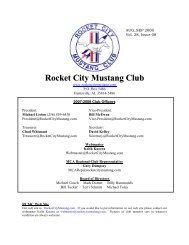2006 Ford Racing Performance Parts Catalog - Rocket City Mustang ...
2006 Ford Racing Performance Parts Catalog - Rocket City Mustang ...
2006 Ford Racing Performance Parts Catalog - Rocket City Mustang ...
Create successful ePaper yourself
Turn your PDF publications into a flip-book with our unique Google optimized e-Paper software.
289/302/351W/351C/351M/400<br />
SIX WAYS TO BUILD A WINNER<br />
<strong>Ford</strong> has manufactured millions of small block<br />
V-8s over the past 30 years, and <strong>Ford</strong> <strong>Racing</strong><br />
parts are available for many of them. You have<br />
a choice of six engines to modify (eight, if you<br />
count two high performance BOSS versions).<br />
So you’ve got great flexibility working for you,<br />
whether you begin with a complete engine<br />
assembly or a bare block. All have four-inch<br />
bores, but there are differences that affect parts<br />
interchange. For example, the water passages<br />
described on page 220. Here’s a brief description<br />
of <strong>Ford</strong> small blocks.<br />
289/302<br />
The 289 was produced from 1963 through 1968,<br />
and the 302 from 1968 to the current model year.<br />
They’re very similar, except for stroke. Of special<br />
interest is the 289-4V Hi-<strong>Performance</strong> engine<br />
(1963-67) with mechanical camshaft, threaded<br />
rocker arm stud (adjustable) and a recessed<br />
spring seat. Most other 289/302 (1968-76)<br />
engines use a press-in stud. 1978 and later<br />
302 engines use a modified pedestal as shown<br />
on page 226. Many 289/302 parts fit earlier<br />
221/260 engines (which had smaller bores).<br />
They also had less metal around the bores,<br />
so you can’t overbore to come up with a 289.<br />
The 1985 model <strong>Mustang</strong> GT introduced a new<br />
high-output 302 with roller tappet camshaft.<br />
Electronic fuel injection was added in 1986.<br />
302 BOSS<br />
This is certainly one of <strong>Ford</strong>’s all-time super<br />
engines. The 302 BOSS (1969-70) proved to<br />
be very competitive in 5 liter TransAm racing.<br />
It featured big breathing heads with canted<br />
valves, mechanical cam, stamped rocker arms<br />
with a threaded adjustable stud, push rod guide<br />
plates, forged crankshaft, 4-bolt main caps<br />
(#2, #3 and #4 journals), beefy con rod with<br />
spot-face for .375" bolt and forged pistons.<br />
351W (WINDSOR)<br />
The Windsor engine plant builds this engine;<br />
hence the name. Normally, this isn’t important.<br />
But another engine, the 351C (for Cleveland<br />
engine plant), has the same displacement.<br />
That’s about all they have in common.<br />
So, it’s always important to differentiate between<br />
the two. The 351W is a beefier block than the<br />
289/302, but has the same bore spacing (4.38")<br />
and bore diameter (4.00"), so heads retrofit.<br />
A higher deck height requires a unique intake<br />
manifold. Main journals (3.00") are larger than<br />
the 289/302 (2.25"). Camshafts interchange,<br />
but the 351W has a different firing order:<br />
(1-3-7-2-6-5-4-8) vs. (1-5-4-2-6-3-7-8) for<br />
the 289/302, except 1982 and later 302 HO<br />
which use the 351W firing order. The 351W<br />
has been used from 1969 to the current year.<br />
289 Hi-Per<br />
351W<br />
302 BOSS<br />
5.0L H.O. (SEFI)<br />
MODULAR V-8 ENGINES<br />
4.6L SOHC, 4.6L DOHC, 5.4L SOHC<br />
In 1991, <strong>Ford</strong> unleashed a new era of muscle, one that is propelling us into the future. The Modular<br />
engine focuses on low friction, excellent sealing, and increased block stiffness. The design results<br />
in an extremely smooth running engine using aluminum heads and having all accessories rigidly<br />
mounted to the engine. Both the engine block and head are machined to close tolerances to<br />
produce a very precise assembly. The head bolts of modular engines actually extend past the<br />
cylinder bores into the bearing webs, eliminating bore distortion and providing a better head gasket<br />
seal. The sophisticated overhead cam design uses roller finger followers to lower friction and increase<br />
the RPM potential of the engine. On the bottom end, the deep skirt engine block and cross-bolted<br />
main caps contribute to a highly rigid assembly. Two engine plants manufacture Modular engines;<br />
Romeo produces all passenger car versions and Windsor produces the Modular Truck engines.<br />
Here’s a brief description of Modular V-8 engines.<br />
4.6L SOHC<br />
The 4.6L SOHC (2V) was first introduced in 1991. This engine is the basis for all modular engines<br />
and is used in passenger car as well as the trucks. The block is cast iron with a nodular crankshaft,<br />
while the heads are aluminum using an in-line valve design with 1 intake and 1 exhaust valve per<br />
cylinder. All passenger cars have press fit piston pins, while all truck engines have full floating<br />
piston pins to improve durability.<br />
4.6L DOHC<br />
The 4.6L DOHC (4V) was first introduced in the Mark VIII; however, in 1996 a similar version of<br />
this engine found its calling the <strong>Mustang</strong> Cobra. The aluminum block and four valve head make<br />
for a powerful combination producing 305 HP @ 7000 RPM. Internally, the 4 bolt, cross-bolted main<br />
bearing caps provide the support necessary to easily handle the high RPM potential of the forged<br />
steel crankshaft. This engine uses hypereutectic pistons with full floating piston pins and upgraded<br />
connecting rod assemblies to improve durability.<br />
5.4L SOHC<br />
The 5.4L SOHC (2V) “Triton” engine released in trucks for 1997 is producing favorable reactions.<br />
This engine has a cast iron block, forged steel crankshaft, full floating piston pins and special<br />
6000 RPM connecting rods. It is the 5.8L pushrod engine replacement.<br />
*Not legal for sale or use on pollution-controlled motor vehicles.<br />
**Direct replacement part.<br />
www.fordracingparts.com 219




